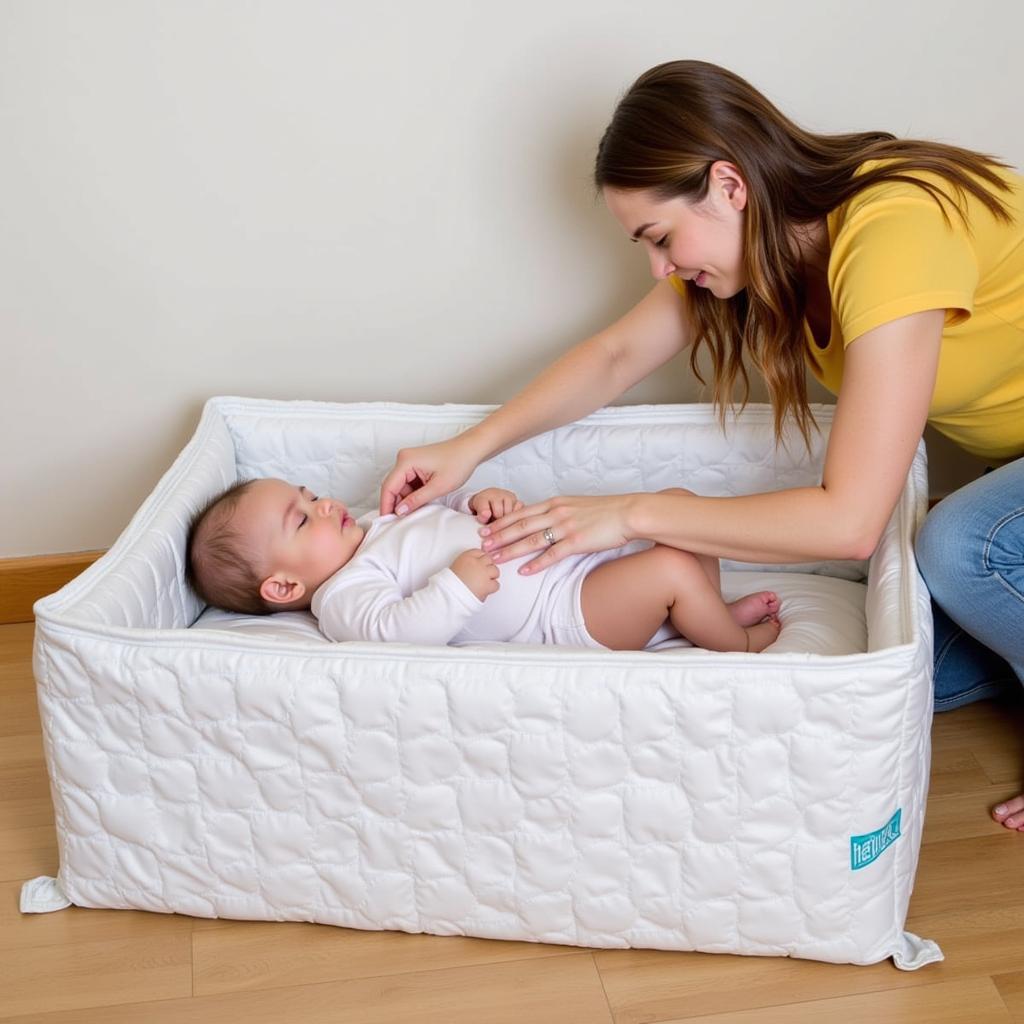Best Floor Cribs for Infants: A Safe and Cozy Sleep Solution
November 21, 2024Floor cribs for infants are becoming an increasingly popular choice for parents seeking a safe, accessible, and minimalist sleeping arrangement for their little ones. This article explores the benefits, considerations, and different types of floor cribs available, empowering parents to make informed decisions for their baby’s sleep environment.
The Growing Popularity of Floor Cribs
Floor cribs offer a unique approach to infant sleeping arrangements, eliminating the need for traditional crib bars and creating a sense of openness and accessibility. They encourage infant independence and motor skill development, allowing babies to easily enter and exit their sleeping space. This design also fosters a close connection between parents and infants, making nighttime feedings and comforting easier.
Benefits of Using a Floor Crib
- Promotes Independence: Floor cribs allow babies to move freely in and out of their sleeping area, fostering self-soothing and independent sleep habits.
- Enhanced Safety: The low profile design reduces the risk of falls and injuries compared to traditional cribs.
- Easy Accessibility: Parents can easily reach their baby for comforting and nighttime feedings without having to lean over high crib rails.
- Montessori-Aligned: Floor cribs are often favored by parents following Montessori principles, promoting child-led development and freedom of movement.
- Space-Saving Design: Floor cribs can be a great option for smaller rooms, offering a sleek and minimalist aesthetic.
 Floor Crib Benefits for Infants
Floor Crib Benefits for Infants
Choosing the Right Floor Crib
Selecting the right floor crib for your infant involves considering several factors, including materials, size, and safety features.
Materials and Construction
Floor cribs are typically made from wood or metal, with various finishes and styles available to match different nursery aesthetics. Ensure the materials used are non-toxic and meet safety standards. Look for sturdy construction and a stable base to prevent tipping or wobbling.
Size and Dimensions
Floor cribs come in various sizes to accommodate growing infants. Consider your baby’s current size and projected growth when selecting a crib. Make sure the crib provides ample space for your baby to move and stretch comfortably.
Safety Features
Safety should be the top priority when choosing a floor crib. Look for cribs with rounded edges and smooth surfaces to prevent injuries. Ensure the crib meets all relevant safety standards and regulations.
Different Types of Floor Cribs
- Traditional Floor Cribs: These resemble standard cribs but sit directly on the floor, eliminating the need for legs or a frame.
- Montessori Floor Beds: These are typically low-profile platforms designed to provide a safe and accessible sleeping space for infants and toddlers.
- Convertible Floor Cribs: Some floor cribs can be converted into toddler beds or playpens, offering extended use and value.
Setting Up Your Floor Crib
Creating a safe and comfortable environment for your baby in their floor crib is essential. Place the crib on a flat, stable surface away from windows, cords, and other potential hazards. Use a firm, breathable mattress specifically designed for cribs. Avoid using loose blankets, pillows, or bumpers, as these can pose a suffocation risk.
Conclusion
Floor cribs offer a unique and beneficial approach to infant sleeping arrangements. By understanding the different types of floor cribs available and considering key safety factors, parents can create a comfortable and nurturing sleep environment for their little ones, promoting independence and a strong parent-child bond. Choosing a floor crib allows you to prioritize your baby’s safety and development while creating a cozy and accessible sleep space.
FAQs
- What age is appropriate for a floor crib?
- Floor cribs are typically suitable from birth until the child can climb out independently, generally around 2-3 years old.
- Are floor cribs safe for newborns?
- Yes, floor cribs can be safe for newborns when used correctly and meet safety standards.
- What type of mattress should I use in a floor crib?
- Use a firm, crib-sized mattress specifically designed for cribs.
- How do I clean a floor crib?
- Clean the crib regularly with a mild soap and water solution.
- Can a floor crib be converted into a toddler bed?
- Some floor cribs can be converted into toddler beds, check the manufacturer’s instructions.
- What are the advantages of a floor crib over a traditional crib?
- Floor cribs promote independence, enhance safety, and offer easy accessibility.
- Where can I purchase a floor crib?
- Floor cribs can be purchased from various retailers, both online and in-store.
Situations with Frequently Asked Questions:
- Safety Concerns: Parents often ask about the safety of floor cribs compared to traditional cribs. Reassure them about the low-profile design and its ability to minimize fall risks.
- Cleaning and Maintenance: Explain how easy it is to clean and maintain a floor crib, using mild soap and water.
- Transitioning to a Toddler Bed: Address concerns about the transition to a toddler bed by highlighting convertible floor cribs as a solution.
Other helpful articles and questions on our website:
- “Creating a Montessori-inspired nursery”
- “Safe sleep practices for infants”
- “Choosing the right crib mattress”
Need support? Contact us: Phone: 0915117113, Email: [email protected] Or visit us: Tổ 3 Kp Bình An, Phú Thương, Việt Nam, Bình Phước 830000, Việt Nam. We have a 24/7 customer support team.